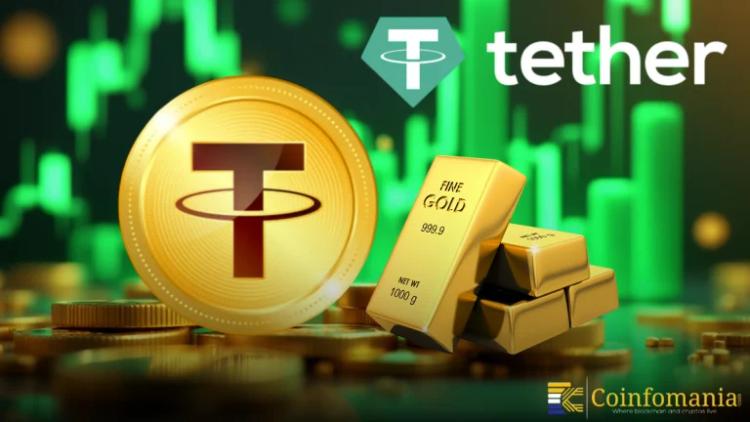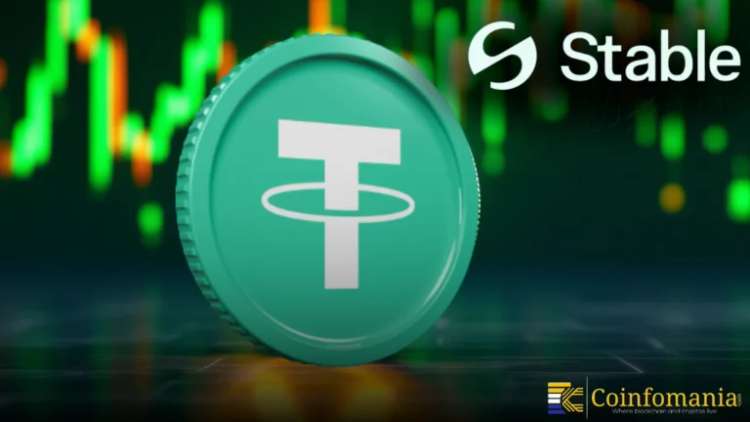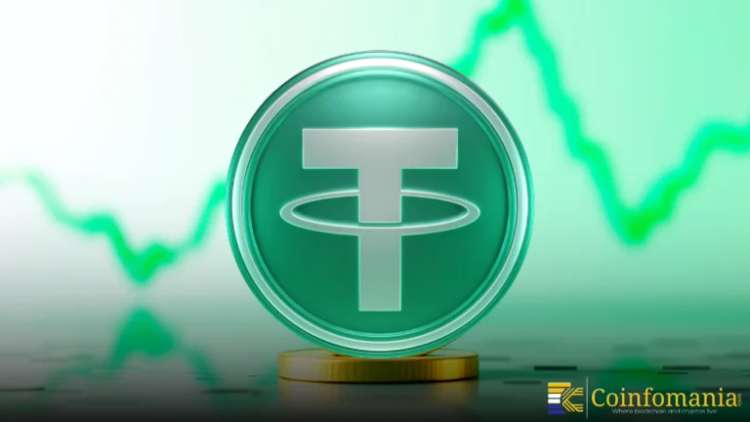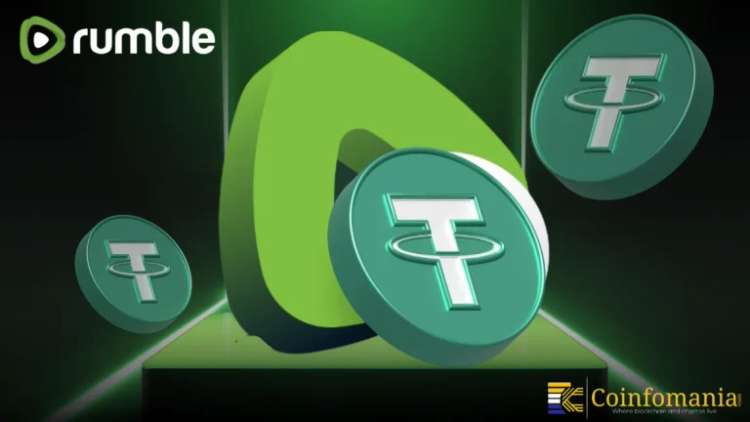USDT
As of December 05, 2025, Tether (USDT) is trading at approximately 1 USD, reflecting a 0.01% increase from the previous close.
| Current Price | 24h Price Change | 7-Day Avg Price | Support Level | Next Resistance |
| $1.00 USD | 0.01% | $1.00 USD | $0.967 USD | $1.01 USD |
📈 Technical Analysis Summary
- Price Movement: The 0.01% increase indicates Bullish momentum; renewed investor confidence.
- 7-Day Average Comparison: Trading below the 7-day average ($1.00 USD); weak or consolidating trend; watch for support breakdown.
- Support and Resistance Levels: Price is above support ($0.967 USD); confirms bullish base. Room for growth before hitting resistance ($1.01 USD).
- RSI Analysis: RSI at 42.09 indicates Neutral zone; balanced market.
- MACD Analysis: Flat MACD (-0.00); no strong directional bias.
📊 Market Sentiment
| Indicator | Value | Interpretation |
|---|---|---|
| RSI | 42.09% | Neutral; neither overbought nor oversold |
| MACD | -0.00 | Bearish; suggests downward momentum |
| Above 7-Day Avg? | No | Indicates bearish pressure or cooling off |
| Above Support? | Yes | Suggests price stability above support. |
Tether Price Prediction Preview
| Forecast Range | Prediction Trend |
|---|---|
| Daily | 📉 Bearish — Caution in the short term due to weakening indicators |
| Weekly | 🔻 Weak — Risk of short-term pullback if support breaks |
| Monthly | N/A |
| Yearly | 🧯 Uncertain — Macro factors may limit long-term upside for USDTUSD |
Related News

Tether Gold Purchases Raise Investor Interest in Stable Assets
Tether, the company behind the popular USDT stablecoin, made a big move in Q3 2025. It bought 26 tons of gold, bringing its total holdings to 116 tons, surpassing most central banks and signaling growing influence in global precious metals markets. The move has caught the attention of investors and analysts worldwide, sparking discussions about […]
Hanan Zuhry
Author

Tether-Backed Stable L1 Unveils STABLE Tokenomics Ahead of Dec 8 Launch
Shweta Chakrawarty
Author

Tether Stability Defended as USDT FUD is Disputed by Experts
Hanan Zuhry
Author

Tether Strong Pushback After S&P’s USDt Downgrade Sparks a New Debate
Vandit Grover
Author

Rumble Shares Jump As Tether Deepens Its Stake In The Video Platform
Vandit Grover
Author
Tether (USDT) operates as a digital dollar, launched in 2014 to match the US dollar's value 1:1. Now in 2025, it remains crypto's most-used stablecoin because it solves a key problem: volatility. When crypto prices swing wildly, traders park funds in USDT. Businesses use it for cross-border payments without traditional banking delays. Three factors explain its dominance: actual dollar reserves (unlike some stablecoins), acceptance on every major exchange, and compatibility with multiple blockchains. Though not for earning profits, USDT has become essential infrastructure - like digital cash that makes the crypto economy function smoothly every day.
How Tether (USDT) Maintains Its Value
Tether's stability comes from a simple promise: every USDT in circulation is backed by real assets. Here's how the system functions:
The 1:1 Dollar Backup
- Tether Ltd. holds actual dollars/safe investments for each USDT created.
- These reserves include bank deposits and short-term bonds.
- Independent accountants verify the funds periodically.
Token Management
- New USDT enters circulation when users deposit dollars.
- The process works in reverse when redeeming tokens.
- This inflow/outflow mechanism keeps the price steady.
Unlike regular cryptocurrencies that rise and fall, USDT mimics traditional money - but with blockchain's speed for transfers. The company's transparency about reserves helps maintain trust in the peg.
Tether and the Crypto Ecosystem
Unlike traditional cryptocurrencies that fluctuate in value, USDT serves as a stable bridge within the digital asset space. Its fixed $1 value creates essential stability for three key crypto activities:
How Traders Use USDT With Other Coins
- Acts as a safe parking spot between Bitcoin/altcoin trades.
- Allows quick exit from volatile positions without cashing out to fiat.
- Serves as the base trading pair for most crypto assets.
Tether Unique Advantages Over Volatile Cryptocurrencies
- Maintains value when other coins crash.
- Processes transactions faster than moving actual dollars.
- Available on more exchanges than any single cryptocurrency.
While Bitcoin and Ethereum capture headlines, Tether quietly powers the day-to-day operations of crypto markets through its unique stability.
The Tech Powering Tether (USDT)
USDT works across multiple blockchain networks including Ethereum, Tron, Solana and Kaia. This multi-chain approach gives users flexibility to select the most suitable network for their transactions based on speed, cost or compatibility needs. By operating on several platforms, Tether enables more efficient and adaptable digital dollar transfers.
By supporting multiple blockchains, Tether ensures faster and more flexible transactions. Each network has its own advantages—Ethereum offers wide adoption, Tron provides low fees, Solana ensures high-speed transfers, and Kaia brings new possibilities. This adaptability makes USDT a convenient option for traders, investors, and everyday users.
The infrastructure behind Tether is designed to maintain smooth cross-chain transfers. Whether moving funds between exchanges or using them in decentralized applications, USDT’s technology helps maintain stability and efficiency. Working across multiple blockchains helps Tether connect regular money systems with cryptocurrency markets more effectively.
Is Tether (USDT) a Smart Investment?
USDT is built to maintain a fixed $1 value, not to increase in price like other cryptocurrencies. Its main purpose is providing stability and liquidity in crypto markets. While USDT won't increase in value, it helps traders avoid price swings when moving between assets. Tether serves specific functions rather than being an investment asset:
Key Characteristics
- Price-stable by design (always targets $1 value).
- Acts as a safe harbor during crypto market storms.
- Enables instant transfers between exchanges.
Practical Uses
- Serves as a trading pair for 80%+ crypto transactions.
- Allows quick exit from volatile positions.
- Facilitates cross-border payments with low fees.
Considerations
- Not for profit-seeking investors.
- Faces ongoing regulatory scrutiny.
- Requires trust in reserve backing.
While USDT won't generate returns, it plays a vital role as crypto's most liquid dollar substitute.
Rules and Regulations for Tether in 2025
Tether faces stricter oversight in 2025, especially in Europe under new crypto rules (MiCA). Since USDT hasn't sought EU approval, some European exchanges now limit its trading. Meanwhile, Tether plans a separate U.S. dollar stablecoin to meet American regulations, showing its attempts to navigate different countries' financial laws.
How to Purchase and Trade Tether (USDT)
Purchasing USDT is straightforward:
- Pick a trusted exchange (like Binance or Coinbase) that offers USDT trading.
- Register an account and finish the required ID checks.
- Deposit Funds: Add funds to your account using fiat currency or other cryptocurrencies.
- Buy USDT: Place an order to purchase USDT.
- Store Securely: Transfer your USDT to a secure wallet for safekeeping.
Tether (USDT) Wallets and Security
Tether holders can choose from different wallet types based on their security needs and usage frequency:
Cold Storage (Maximum Security)
- Hardware wallets (Ledger/Trezor) keep USDT completely offline.
- Immune to online hacking attempts.
- Requires physical device for transactions.
Hot Wallets (Convenient Access)
- Mobile/desktop apps (Trust Wallet, Exodus) enable quick transactions.
- Suitable for frequent traders.
- Less secure than hardware options.
Exchange Accounts (High Risk)
- Useful for active trading.
- Vulnerable to platform breaches.
- Not recommended for long-term holdings.
The safest approach combines hardware wallets for savings with software wallets for smaller, usable amounts.
Protecting Your Tether (USDT) Assets
Security Measures
- Cold Storage for Large Amounts: Use hardware wallets like Ledger or Trezor to keep bulk USDT offline and hacker-proof
- Two-Step Verification: Turn on 2FA for all exchange and wallet logins to block unauthorized access
- Software Maintenance: Install the latest updates for wallets and devices to patch security gaps
- Scam Awareness: Double-check website URLs and sender emails before entering credentials or sending tokens
Proactive Habits
- Separate Storage: Keep spending amounts in hot wallets and savings in cold storage
- Transaction Verification: Always review recipient addresses before sending - copied addresses may be malware-generated
- Backup Protection: Secure wallet seed phrases in fireproof/waterproof containers, never digitally
Tether (USDT) Adoption and Use Cases
Tether (USDT) continues expanding its real-world usage through strategic partnerships and market dominance. Its recent integration with Kaia blockchain via LINE NEXT exposes the stablecoin to millions of Asian users familiar with mobile payments. This push into everyday spending complements its established role in crypto trading and finance.
Key Use Cases
- Cross-border payments: Enables fast, low-cost money transfers globally.
- Crypto trading: Serves as the most traded pair on exchanges.
- DeFi lending: Backs over 73% of crypto loans as preferred collateral.
- Mobile commerce: Powers transactions in LINE's web3 ecosystem.
- Inflation hedge: Used in unstable economies to preserve value.
The stablecoin's multi-chain presence and liquidity make it a versatile tool across both traditional and decentralized finance systems.
Tether (USDT) Future Outlook & Growth Potential
Growth Factors
- Regulatory compliance efforts strengthen institutional trust
- Potential U.S.-focused stablecoin shows adaptation to local laws
- Ongoing blockchain integrations expand accessibility
- Reserve transparency improvements address audit concerns
Challenges
- Increasing competition from government-backed digital currencies
- Regulatory scrutiny across multiple jurisdictions
- Need to prove 1:1 backing during market stress
Potential Developments
- Deeper banking partnerships for smoother fiat conversions
- More merchant adoption through payment processors
- Enhanced utility in smart contract platforms
The stablecoin's future depends on balancing innovation with financial safeguards as the digital asset landscape evolves.
Benefits and Drawbacks of Tether (USDT)
Pros
- Steady Value: Always equals $1, avoiding crypto price swings.
- Easy Trading: Available on nearly all crypto exchanges.
- Fast Transfers: Enables quick, low-cost payments globally.
Cons
- Legal Risks: Faces ongoing government scrutiny worldwide.
- Central Control: Run by one company, not decentralized like Bitcoin.
- Limited Investment Potential: Not designed for capital appreciation.
Conclusion
Tether remains the go-to digital dollar for crypto markets, offering a safe harbor when prices swing wildly. Though handy for quick trades and money moves, users must keep up with new rules and guard their tokens carefully. Tether must regularly prove it has enough cash reserves and follow global financial rules to stay relevant.
Frequently Asked Questions
What is Tether (USDT)?
Tether acts as digital cash that always matches the US dollar's worth. While cryptocurrencies like Bitcoin jump up and down in value, USDT remains fixed at $1, making it stable for everyday use. This stability comes from Tether Limited keeping real dollars in reserve to match every USDT they issue.
How does Tether maintain its value?
Each USDT is backed by actual dollars held in reserve, including cash and safe investments like government bonds. Independent audits periodically verify these holdings to confirm the 1:1 backing.
Is USDT used on different blockchain networks?
USDT works on multiple blockchains including Ethereum, Tron, and Solana, giving users options for faster or cheaper transactions. The Kaia blockchain integration further expands its reach in specific markets.
Is Tether used for everyday transactions?
In many Asian markets, USDT functions like digital cash for everyday purchases and payments. Its integration with platforms like Kaia blockchain makes transactions faster and more accessible locally. This practical use helps people avoid currency fluctuations during routine spending.
Is Tether (USDT) a smart choice for investors?
Tether provides price stability but faces ongoing questions about its reserve backing. USDT remains at $1, avoiding Bitcoin's violated price - this stability works better for daily payments.
What are the risks associated with Tether?
Tether faces ongoing legal challenges from financial regulators worldwide. Doubts persist about whether its dollar reserves fully cover all USDT in circulation. Unlike decentralized cryptocurrencies, Tether's centralized control by a single company creates potential vulnerabilities.
How to acquire Tether?
Buying Tether USDT is simply registered under trusted crypto exchanges like Binance or Coinbase. Buy it through regular currency (dollars, euros) or swap with other cryptocurrencies for USDT. This stablecoin serves as a common entry point for crypto trading due to its stable value.
What is the expected price of Tether (USDT) in 2030?
Tether (USDT) stable $1 value is expected to remain the same till 2030. Market analysts suggest potential increases in 2026 of about $1.05, in 2028 at $1.16, and by 2030 at $1.28. These are just speculations that can change due to violating the market.
How can users potentially earn from holding USDT?
Users earn trading fees by putting USDT and another coin like ETH into exchange pools. When others swap between these tokens, the pool providers get a cut of the fees. This process, known as liquidity provision, pays rewards when others swap between the paired tokens. Be warned - if the token values shift significantly, providers might get back less than they deposited when withdrawing funds.
What is the future of Tether?
Tether must do three things to stay important: show it has enough real cash backing every USDT, follow changing money rules worldwide, and keep users happy. If people can't see clear proof of Tether's dollar reserves, they might stop trusting its $1 value promise. The company needs to handle these challenges well to keep USDT useful in crypto markets.